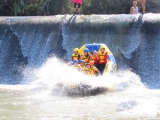The descent can be done alone, in a canoe or kayak, or as a couple or in a group. For groups, the descent down the Deva River is always done in a pneumatic rafting raft.Of course, to make the descent it is always an essential requirement to know how to swim, since with the river you must always respect the waters. In addition, it is always essential to use a life jacket that guarantees your buoyancy, in case you fall into the water.
There are different sections to do depending on the level of difficulty.

To practice descending the Deva River, you will normally use the same equipment that is usually used in other rivers. The first thing is the kayak or canoe, or in the case of a group the Rafting raft. Then a closed helmet for practicing adventure sports in the river, a neoprene suit, booties or water shoes and a paddle, which in the case of rafting is simple and in the case of kayaking or canoeing, has a double blade. Finally, the life jacket, which must always be worn correctly adjusted, so that it does not move and is safe.

The rest of the equipment, whether ropes such as a small first aid kit or raft repair tools, in the case of rafting, will always be carried by the guide, who will monitor us and give us the orders to row at all times.
- Family rafting 7 km from €30. Level III-IV. Section from Puente El Infierno to Puentelles(The minimum age is 10-12 years)
- 2-hour rafting descent from €35 (The minimum age is 14 years old)
Kayak and canoe descent offers
- 12 km descent from €35Section from Panes to Unquera (Minimum age is 8 years)
- River descent 3 hours from €23 Descent in the upper section or section low.
- 2-3 hour descent +picnic
- --> Child price €20 (under 13 years old)
- -->Adult price €25(Sections from Panes to Unquera)
Try doing any of these activities because this spring-summer is full of adventure.
The Deva welcomes thousands of adventure tourism fans who complete the descent down the river, by paddling with the current, spending an unforgettable day on the water, dotted with emotion and adventure. Also, enjoying a natural environment on the Cantabrian coast.
The Deva River rises in Fuente Dé, a town famous for the cable car that takes us to the routes that can take us to the Aliva Refuge or Cabaña Verónica. Its waters then flow through Cantabria and Asturias with a total length of 64 kilometers. Its mouth is in the Cantabrian Sea, in the Tina Mayor estuary. As its largest tributary, it has the Cares River, 50 km long, famous for running along the Cares Route, one of the most famous hiking routes in northern Spain.

As the Deva River passes through the towns of Bustio (Ribadedeva), Vilde (Ribadedeva), Buelles (Peñamellera Baja), Panes, a town famous for being between Asturias and Cantabria, (capital of Peñamellera Baja) and Cuñaba (Peñamellera Baja).
As for the name, it is due to a deity from the times of the Cantabrian warriors, known as the goddess Deva. This name, surely of Celtic origin, may be related to the word god.
Are you up for a relegation?
















